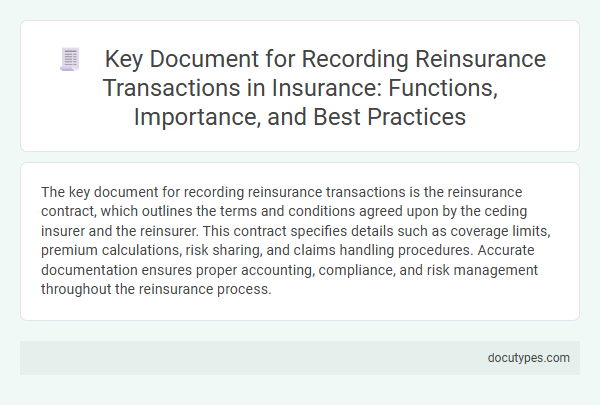The key document for recording reinsurance transactions is the reinsurance contract, which outlines the terms and conditions agreed upon by the ceding insurer and the reinsurer. This contract specifies details such as coverage limits, premium calculations, risk sharing, and claims handling procedures. Accurate documentation ensures proper accounting, compliance, and risk management throughout the reinsurance process.
Introduction to Reinsurance Documentation
Reinsurance documentation is essential for accurately recording and managing reinsurance transactions. Understanding the key documents involved helps ensure compliance and clarity in your insurance operations.
- Reinsurance Treaty - A comprehensive agreement outlining the terms and conditions between the ceding insurer and reinsurer.
- Accounting Statements - Detailed records of premiums, losses, and commissions exchanged between parties.
- Certificate of Reinsurance - A formal document confirming the coverage and terms agreed upon in the reinsurance contract.
The reinsurance treaty stands out as the primary document for recording and governing reinsurance transactions effectively.
Definition and Types of Key Reinsurance Documents
| Key Document | Reinsurance Agreement |
|---|---|
| Definition | A Reinsurance Agreement serves as the primary legal contract between the ceding insurance company and the reinsurer. It outlines the terms, conditions, coverage limits, and financial responsibilities involved in the reinsurance transaction. This document ensures clear recording, administration, and enforcement of reinsurance arrangements. |
| Types of Key Reinsurance Documents |
|
Core Functions of Reinsurance Transaction Records
The key document for recording reinsurance transactions is the reinsurance contract, which serves as the primary reference for terms, conditions, and financial obligations between the insurer and reinsurer. It ensures accurate documentation of risk transfer, premium calculations, and claims settlements within the reinsurance process.
- Legal Framework - Defines the binding terms and responsibilities agreed upon by both parties in the reinsurance transaction.
- Financial Record - Details premium amounts, commissions, and payment schedules essential for accurate financial accounting and reporting.
- Claims Documentation - Records procedures and criteria for claims handling, ensuring clarity in indemnity settlements between insurer and reinsurer.
Importance of Accurate Documentation in Reinsurance
The key document for recording reinsurance transactions is the reinsurance contract, which outlines the terms, conditions, and obligations between the cedent and the reinsurer. Accurate documentation ensures clarity in risk transfer, premium payments, and claim settlements, reducing disputes and financial discrepancies. Proper record-keeping supports regulatory compliance and enhances transparency within the reinsurance process.
Essential Elements of Reinsurance Contracts and Slips
The key document for recording reinsurance transactions is the reinsurance slip. This slip serves as a summary of the essential terms and conditions between the ceding insurer and the reinsurer.
Essential elements of reinsurance contracts include the names of involved parties, the type and scope of coverage, and the premium amounts. The slip also details the effective dates, limits of liability, and conditions for claims handling.
Regulatory Requirements for Reinsurance Record-Keeping
The key document for recording reinsurance transactions is the reinsurance contract, which outlines the terms and obligations between the insurer and reinsurer. Regulatory requirements mandate detailed documentation and accurate record-keeping to ensure transparency and compliance with solvency standards. Maintaining these records supports audit trails, facilitates risk assessment, and helps meet the reporting demands of insurance regulatory authorities.
Challenges in Recording Reinsurance Transactions
The key document for recording reinsurance transactions is the reinsurance treaty, which outlines the terms, conditions, and obligations between the ceding insurer and the reinsurer. Proper documentation ensures accurate accounting, compliance, and risk management in insurance operations.
Challenges in recording reinsurance transactions include complexity in contract terms, timing differences in recognition, and reconciliation of balances between parties.
- Complex Contract Terms - Detailed clauses in reinsurance treaties can lead to interpretation difficulties affecting transaction recording.
- Timing Differences - Variations in premium and claim reporting periods between insurers and reinsurers create challenges in consistent accounting.
- Balance Reconciliation - Discrepancies in reported amounts require frequent reconciliation efforts to maintain accurate records.
Best Practices for Managing Reinsurance Documents
The key document for recording reinsurance transactions is the reinsurance contract or treaty. This document outlines the terms, conditions, and obligations between the ceding insurer and the reinsurer.
Best practices for managing reinsurance documents include maintaining organized, secure digital records to ensure easy access and retrieval. Regular audits of reinsurance contracts help verify accuracy and compliance with regulatory requirements. Clear documentation supports transparency and effective risk management in insurance operations.
Technology Solutions for Reinsurance Documentation
What is the key document for recording reinsurance transactions in the insurance industry? The key document is the reinsurance contract, which outlines terms, conditions, and obligations between the cedent and reinsurer. Modern technology solutions streamline the management and storage of these contracts, ensuring accuracy and easy access.
How do technology solutions improve the handling of reinsurance documentation? Advanced software platforms automate data entry, track contract changes, and facilitate compliance with regulatory standards. Your reinsurance transactions become more transparent and efficiently recorded through digital document management systems.
What Is the Key Document for Recording Reinsurance Transactions? Infographic

